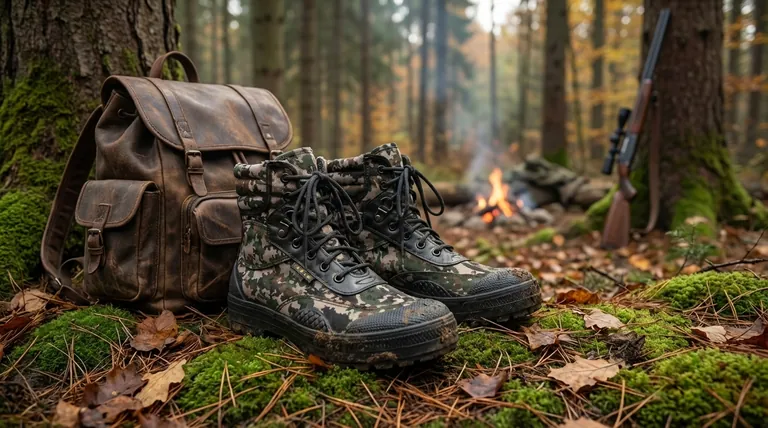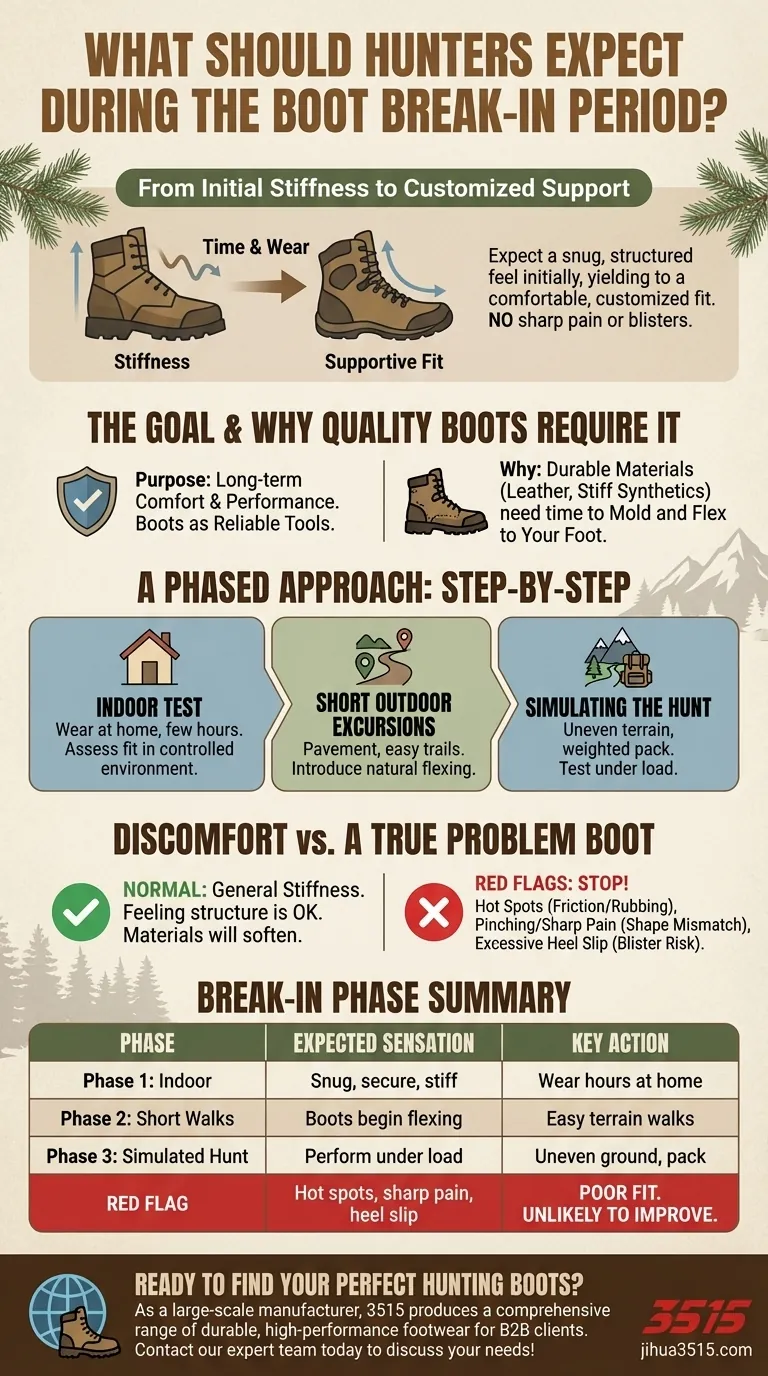Breaking in new hunting boots is a critical process of molding them to the unique shape of your feet. You should expect an initial period of stiffness where the boots feel structured and snug, but this should not involve sharp pain or blisters. Over a period ranging from a few hours to several days of wear, this stiffness will gradually yield to a supportive, customized fit that feels like a natural extension of your foot.
The purpose of breaking in hunting boots is to allow quality materials to flex and conform to your foot, not to endure pain. Significant discomfort, like hot spots or pinching, is a clear signal of a poor fit, not a necessary part of the process.

The Goal of the Break-in Period: From Stiffness to Support
The break-in period is an investment in future comfort and performance. It ensures that on a long hunt, your boots are a reliable tool, not a source of painful distraction.
Why Quality Boots Require It
High-quality hunting boots are built with durable, supportive materials like leather or stiff synthetics. These materials are chosen for their ability to protect your feet and ankles on uneven terrain, but their initial rigidity means they need time to mold to your foot's specific dimensions and flex points.
What You Should Feel
Initially, a new pair of boots should feel snug and secure all around your foot, with no major slipping in the heel. The feeling is one of firm support, not painful constriction.
The Timeline Varies
The break-in time depends entirely on the boot's construction. A flexible, lightweight boot might feel perfect out of the box, while a rigid, full-grain leather mountain boot may require a more deliberate, multi-day approach.
A Phased Approach to Breaking In Boots
A gradual process allows you to identify potential issues early, long before you are miles from the trailhead. Always wear the same type of socks you plan to hunt in during this process.
Phase 1: The Indoor Test
Start by wearing your new boots around the house for a few hours at a time over one or two days. This allows you to assess the general fit and identify any immediate, obvious points of discomfort in a controlled environment.
Phase 2: Short Outdoor Excursions
Once they feel comfortable indoors, begin wearing them for short walks on pavement or easy trails. This introduces the dynamic stresses of walking and helps the boot begin flexing naturally with your foot.
Phase 3: Simulating the Hunt
Finally, wear the boots on more challenging terrain with a weighted pack. Walking on hills and uneven ground is the ultimate test, as it mimics the conditions of an actual hunt and reveals how the boots perform under load.
Discomfort vs. A True Problem Boot
Understanding the difference between normal break-in sensations and red flags is the most important skill in this process.
Normal: General Stiffness
Feeling the boot's structure around your foot is normal. The materials, especially the midsole and leather uppers, will feel rigid at first. This is the very quality that will later provide excellent support.
Red Flag: Hot Spots
A hot spot is a localized area of friction or rubbing that feels warm or abrasive. This is the precursor to a blister. If you feel one developing, stop immediately. It is a sign of a poor fit in that specific area that is unlikely to improve.
Red Flag: Pinching or Sharp Pain
Sharp, pinching pain, often across the top of your foot or in the toe box, indicates a fundamental mismatch between the boot's shape and your foot's shape. This will not get better with time; it will only get worse.
Red Flag: Excessive Heel Slip
While a tiny amount of lift in the heel is acceptable, your heel should feel securely locked into the back of the boot. If it slides up and down more than a quarter-inch with each step, you will develop severe blisters.
Making the Right Choice for Your Hunt
Use the break-in period as the final step in your boot selection process. Your observations will tell you if you've made the right choice.
- If your primary focus is confirming a good fit: Proceed with the phased approach, paying close attention to any hot spots or pinching, which are signs to stop and return the boots.
- If your primary focus is preparing for a hunt: Use the break-in process to also test your lacing techniques, ensuring you can lock your heel in place without cutting off circulation.
- If your primary focus is long-term durability: Remember that stiffer, more robust boots often require a longer break-in period, which is a trade-off for their extended service life and superior support.
A properly broken-in boot becomes a trusted piece of equipment, empowering you to focus entirely on the hunt, not your feet.
Summary Table:
| Break-in Phase | Expected Sensation | Key Action |
|---|---|---|
| Phase 1: Indoor Test | Snug, secure feel; general stiffness | Wear for a few hours at home to assess fit |
| Phase 2: Short Walks | Boots begin to flex naturally | Walk on easy terrain to introduce movement |
| Phase 3: Simulated Hunt | Boots perform under load | Test on uneven ground with a weighted pack |
| Red Flag (Stop!) | Hot spots, sharp pain, excessive heel slip | Indicates a poor fit; unlikely to improve |
Ready to Find Your Perfect Hunting Boots?
As a large-scale manufacturer, 3515 produces a comprehensive range of durable, high-performance footwear for distributors, brand owners, and bulk clients. Our production capabilities encompass all types of hunting boots designed to provide superior support and long-term comfort after a proper break-in.
Let us help you equip yourself or your customers with reliable footwear that becomes a trusted part of the hunt.
Contact our expert team today to discuss your hunting boot needs and discover the 3515 advantage!
Visual Guide

Related Products
- Wholesale High-Traction Camo Boots - Custom Manufacturer for Brands
- Factory-Direct Wholesale Canvas Boots with High-Traction Rubber Soles
- Durable Spiked Camouflage Boots Wholesale & Factory Production
- Safety Footwear Wholesale Manufacturer for Custom OEM/ODM Production
- Wholesale Waterproof Tactical Boots Custom Suede & High-Traction Soles
People Also Ask
- What are some real-world applications of military camouflage boots? From Tactical to Trendsetting
- What benefits do the men's camo boots provide? Superior Protection & Comfort for Demanding Terrain
- How did camouflage use develop during the World Wars? From Artistic Disruption to Scientific Concealment
- What technologies are used in the men's 8-inch camo lace-up boots? A Guide to Rugged Outdoor Performance
- Why might wearing multiple pairs of socks be counterproductive? Avoid This Common Cold-Weather Mistake



















